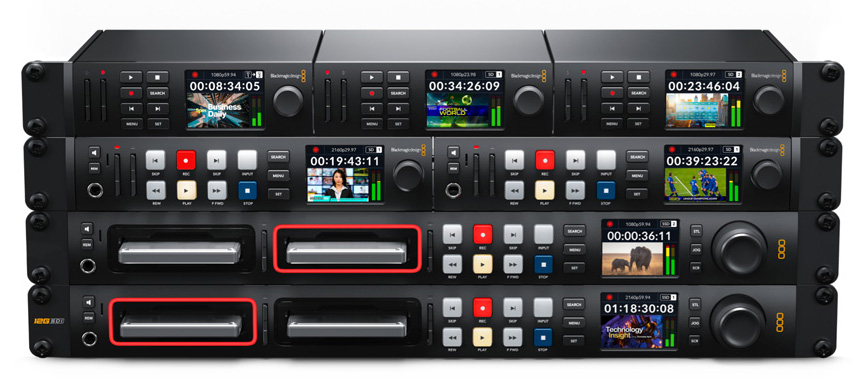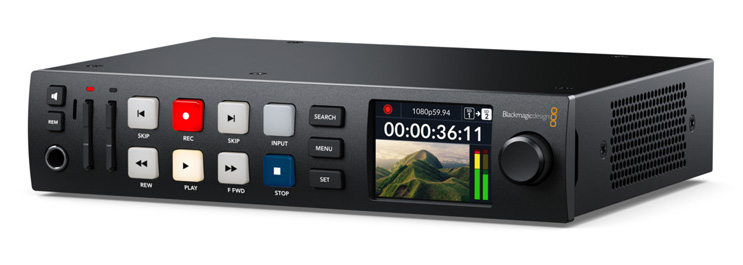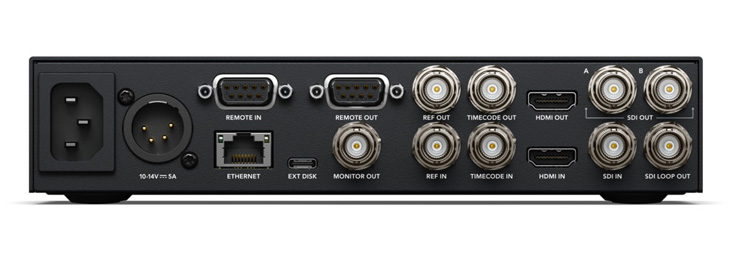Blackmagic revamps all four HyperDeck Studio with new design and more features
The four HyperDeck Studio models of Conception Blackmagic have been refreshed with new design and features to address the latest industry needs.
The completely redesigned HyperDeck Studio recorders let you use SD cards and SSD drives to record high quality video in H.264, ProRes and DNxHD files, with PCM or AAC audio, or H.265 for the 4K version. They also generate timecode and reference signals to record in isolation and synchronize multiple units.
There are four HyperDeck Studio models to suit different types of jobs. The HD Mini model includes 3G SDI connections and records H.264, ProRes or DNxHD (1080p60) files to SD and UHS-II cards or external USB drives. The HD Plus version features enhanced playback controls, front panel speaker and headphone jack, 6G SDI outputs for alpha channel and main picture playback, SDI monitoring, and recording to H.264 (1080p60) or ProRes and DNxHD (2160p30) files. Le HD Pro model also includes two SSD bays and a machined metal rotary search knob. Finally, the 4K Pro model records H.264, H.265, ProRes or DNx (2160p60) files in all resolutions.
Controls, cards and SSD
Le HyperDeck Studio models include traditional playback controls and a rotary seek knob. The display allows image monitoring, volume control and metering mode selection (VU or PPM) with “technically accurate ballistics”.
All models support recording on common SD and UHS-II cards. In addition, the Pro versions include two SSD drive bays and offer the possibility to connect external USB drives. For example, a 1 TB card provides the opportunity to record up to 58 hours of UHD 2160p60 (H.265) or 157 hours in 1080p59.94 (H.264) resolution, i.e. more than six days of high-definition images.
All models include two memory card slots for uninterrupted recording, as the device automatically uses the second unit when the first has no more capacity.
Broad codec support
HyperDeck models support the most commonly used codecs, e.g. DNx, ProRes and H.264 avec 10-bit 4:2:2 quality when recording in NTSC, PAL, 720p, 1080p and 1080i, or even H.265 (UHD) with the 4K version. This allows compression ratios from 60:1 to 285:1 to achieve small files with high quality images. In addition, when uploading to YouTube, it is possible to choose the audio format (PCM or AAC). All HyperDeck devices support ExFAT and HFS+ systems and provide the opportunity to save long recordings in a single file. The Plus and Pro models support ProRes 4444 files for alpha channel and main picture playback.
Specifically, the HyperDecks can process content in SD (NTSC and PAL), HD 720 (720p50, 59.94), HD 1080 (1080i50, 59.94; 1080p23.98, 24, 25, 29.97, 30, 50, 59.94, 60; 1080 PsF) and UHD (2160p60) in the case of the 4K version, which also supports DCI 2K and 4K images at a maximum frequency of 30p.
Similarly, its support for high dynamic range images enables cinematic projects to be realized. When recording, the SDI and HDMI inputs automatically detect these images, and the files are labeled with the corresponding information. PQ and HLG static metadata formats are processed according to the ST2084 standard. HyperDeck Studio Plus and Pro models even provide the opportunity to use b tables to change the appearance of the footage.
HyperDeck Connections
HyperDeck Studio recorders offer a wide range of connections (3G, 6G or 12G SDI, depending on the model), and all include an HDMI output for connecting projectors and TVs. The Pro and Plus versions have an SDI output for monitoring images and two additional outputs for playing back ProRes 4444 files for overlays with mixers, while the 4K model’s b technology streamlines file copying over networks.
HyperDeck Studio models provide support for numerous programs via the USB port. The recorder is detected as a webcam, making it possible to stream high-quality sources. Thanks to this feature, it is possible to use applications such as Zoom, Microsoft Teams, Skype, Open Broadcaster and XSplit Broadcaster, entre autres.
In addition, HyperDeck Studio models can record up to 16 audio channels. When external monitors are connected, the number of active channels is shown on the display next to the volume indicators. These have been designed to use the appropriate ballistics, and it is also possible to select the metering mode (VU or PPM) via the device’s menus.
Adding an M.2
To avoid the problem of skipping frames if the memory card is too slow or full before replacing it with an empty card, Blackmagic allows an M.2 drive to be added to the HyperDeck Studio 4K Pro model for use as a cache memory. This way, even when using inexpensive storage media or external drives, the M.2 drive will cache content that the media cannot store because it is too slow. When the media is out of capacity, recording continues in the cache memory until it is replaced. This makes it possible to record UHD formats, for example, which require a higher transfer rate, on slower drives or even USB drives with mechanical components.
On a more general level, HyperDeck Studio models record files that are compatible with almost all editing programs. Using the H.264 format, they can be uploaded directly to Internet streaming platforms such as YouTube, Facebook, Vimeo or Twitter. It is also possible to use popular applications such as DaVinci Resolve, Final Cut Pro, Premiere Pro or Media Composer, as the file format is the same as that used in post production, or even create visual effects in Fusion and After Effects. The recorder allows the use of formatted discs on computer equipment, making it easy to edit the material stored on them without copying or transcoding.
Other common features are its sync and timecode generator, which are accompanied by special outputs for these signals, or the possibility of installing several recorders in series and synchronizing them. Thus, for example, three HyperDeck Studio HD Mini can be installed side by side in a rack using the optional Teranex Mini Rack Shelf. Alternatively, the recorder can be combined with other products, such as a Teranex Mini Analog to SDI 12G converter, to process analog sources and digitize them.
Avez-vous aimé cet article ?
Abonnez-vous à notre BULLETIN et vous ne manquerez de rien.







